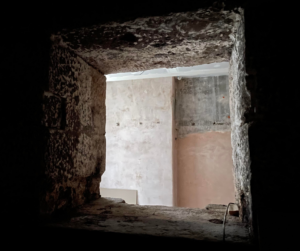I want to start by posing a question. Should you use a cookie cutter approach to your commercial property strategy or a building first approach? Don’t worry, I’m going to explain the difference and there is not a right or wrong way to do this. With the right knowledge and support, both approaches work well. It’s just that over time one may bring more opportunities to you than the other.
Out in the world of property education, there are a whole stack of different strategies to immerse yourself in. It can lead to a bit of a silo approach. In other words, we can become tunnel visioned with a specific strategy, such as HMO and it’s the same in commercial.
Let’s use the example of shops and uppers for a second: (this is where typically a 3 storey building has a shop or retail use on the ground floor and a couple of upper storeys with storage and the like. Nowadays the upper floors can potentially be converted to residential whilst the ground floor remains as a retail unit. Or maybe residential too. Anyway, only specific property types in certain town locations can work for this. It can be a very neat strategy and when done right, it can bring great returns. But it’s narrow in the number of opportunities that any given town or location can provide which means you need to spread the net further.
Before we get too off track, what on earth am I talking about? Let me go into a bit more detail. What I am really saying here is that I think there are two fundamentally different approaches to finding and developing out commercial opportunities.
Cookie Cutter approach
This is where you really latch onto a specific strategy. This might be commercial to residential conversions or shops and uppers or developing restaurant & leisure space. Whatever it is, you concentrate your mind and knowledge into one specific niche. This cuts down on potential mistakes and can be a really good way to get started in commercial.
The great thing is you really get to know your niche and can analyse each building based on your chosen cookie cutter approach.
Building First approach
This is really a multi strategy approach. With this approach, you are looking for problem buildings that are naturally at a discount. Once you identify them, your job is to reimagine their use or the offering. To do this though you need to know your target market to be able to work out the supply & demand bottlenecks. You can find a free Market Analyser tool on our website.
Let’s be clear now, I do have a niche, but I don’t go out there with a cookie cutter approach. I look for the building first which gives me a narrower geographical field of search. My job is to find partially income producing assets and to work out the absolutely best redevelopment and income producing strategy for the vacant space. This way I get to see more opportunities because I am not tied to one strategy such as shops for example. I do of course need to understand a few different strategies that we could employ to get the best out of that property.
To give some structure, here are some reasons why I think a building first approach can be better than a cookie cutter approach.
The Benefits
- You can work in a smaller geographical area with a building first approach. With a Cookie cutter strategy you need to widen your search area which means that you learn less about the local market as your geographical spread will need to widen. For example you go and ask many, many agents for shops & uppers opportunities across much of your county, state or country.
- The building first approach should mean you can be closer to home. I may just be fortunate that all of our investments are within an hour of where I live. I do appreciate though, as we grow we will push out further.
- We are trying to buy property with income already in the deal, but also with space which is at a discount because there is no income attached to it. The actual income reduces that risk and helps with finance. Being specific with agents is really important and by asking for properties with a “partial income” I am asking the agents for a specific property condition but not necessarily a specific property type. There is a difference.
- Because of the narrower spread, you don’t have to form multiple power or at least builder teams because you are working in lots of different geographical areas.
- You really get to know what is going on under the skin of your target market.
- You can get to know the agents better and with that deeper relationship you might be presented with better off-market deals. A big part of finding off market deals is not spreading yourself too thin. If you are trying to cover multiple markets and multiple networks to find deals you may find you are not being as effective as you were hoping to be.
But there is a downside
- You need to have a broader understanding of the different layers in your target market
- You need a depth of strategy ideas, however you don’t have to stray too far from the reservation to be able to come up with a few different ideas. However that deeper understanding of your target market and where the gaps are is critical.
- There could be more risk if you don’t know what you are doing or you haven’t really managed to analyse and spot the “space use” opportunity.
Remember we are fundamentally in the space business. We invest commercial space and our job is to work out what the best use of that space is for the here and now. It could be residential or a residential strategy such as HMO or serviced accommodation or it could be serviced workspace, single occupant or multi-let such as CMO. It might be food & bev or a local shop. Markets change all the time and buildings evolve and adapt as they have done for many years.
A good example of that is bank branches. In particular, the older properties. They tend to have a prominent position on the high street, and many have been closing down. Some have changed into retail space, but others are becoming coffee shops, co-working spaces or offices and in some cases, they have been converted to mixed use with commercial space on the ground floor and residential space on the upper floors.
Another example is that of office pavilions. In some cases they were built for single occupants with large clerical staff. In some areas these single occupants no longer need that many back-office staff or they have moved them offshore. The spaces they once occupied have on occasions been re-let to other single use occupants but other opportunities for the space use have been exploited.
Some of these buildings have been redeveloped into multi-let or CMO properties. Others have even had a change of use with some light industrial replacing the light clerical workers.
The nursing home business is another space provider. It is of course a highly intensive serviced offering, however it is still down to renting space. Some old nursing homes that are not economical to use are now being converted to other forms of use and of course other properties are being converted into care homes. It’s a continuous cycle.
Still the fundamental, common denominator here is that of space.
To me, a cookie cutter approach is a great way to start out, but if you continue with that method you do miss out on the other aforementioned opportunities. If you think about some of the things we have written about, over time space uses change as do trends, so if you approach properties with a narrow viewpoint things might change around you without you ever noticing.
Now as I say this, I am acutely aware of our own strategy mix. We will have to develop our understanding of other strategy areas as we continue to grow our business. Because I want us to have an ever-broader approach when looking at problem buildings. “Every day is a school day” as they say. At the moment, in the main we serve business customers or B2B rather than B2C but we are beginning to offer space for the public too which means we will need to learn new things.
Finally, here is the crux of why I think it is important to try the building first approach. Rules are changing and will continue to do so. This will allow more mixed use spaces to be created rather than the current regimented multitude of commercial classifications or residential classifications. This will help solve the issues with many problem buildings.
I hope that has given you something to think about. Don’t stop what you are doing of course, but take some time to think through what your main approach is. This is the usual self-awareness thing really isn’t it? I am challenging you to look at your current thought process and examine the way you approach things. Perhaps it is time to shake it up a bit? We all need challenging, even those who have been at this for longer. Are you focusing on a cookie cutter and missing other opportunities or have you begun to use the building first approach?
For further information, join our Facebook group to meet others on their commercial property investment journey.
If you are in a hurry then get in touch to see how we can help.






